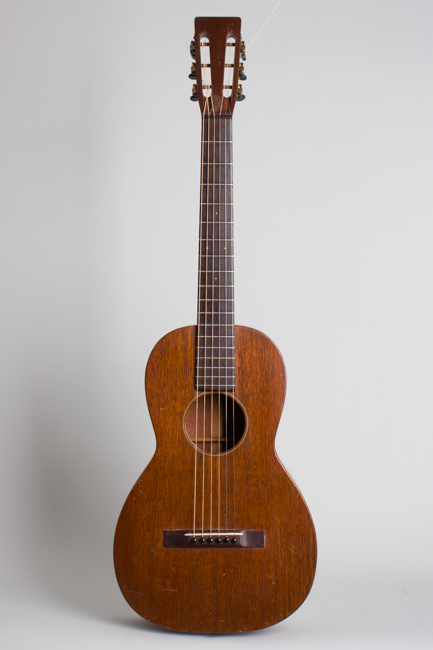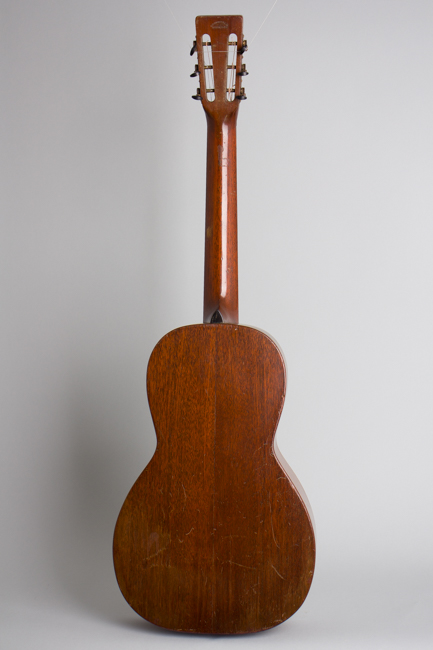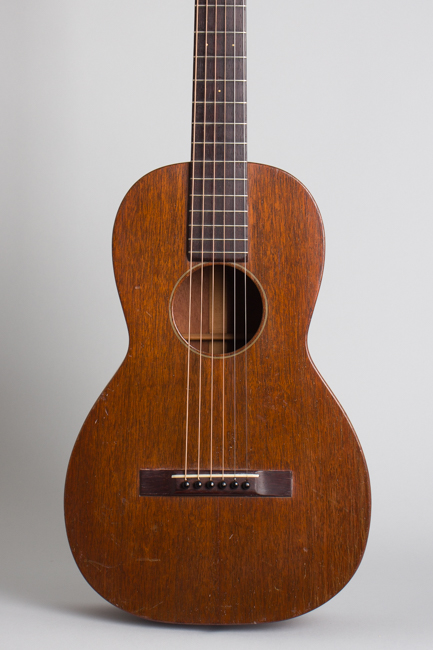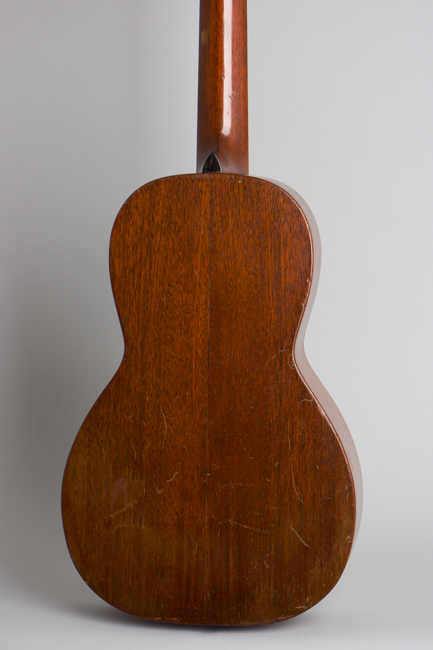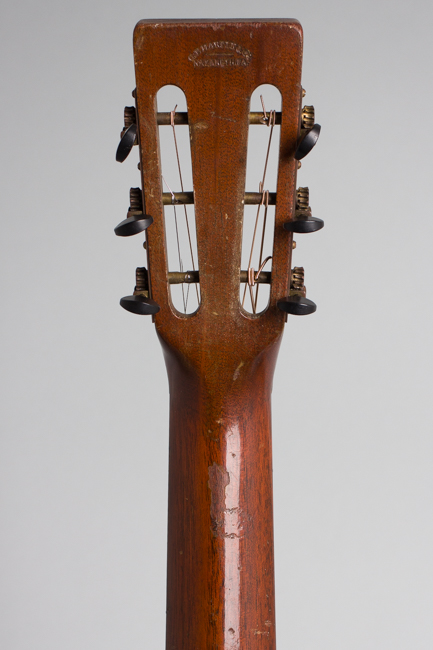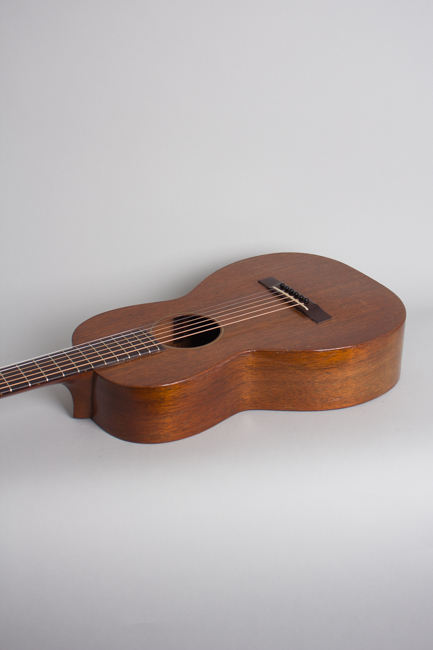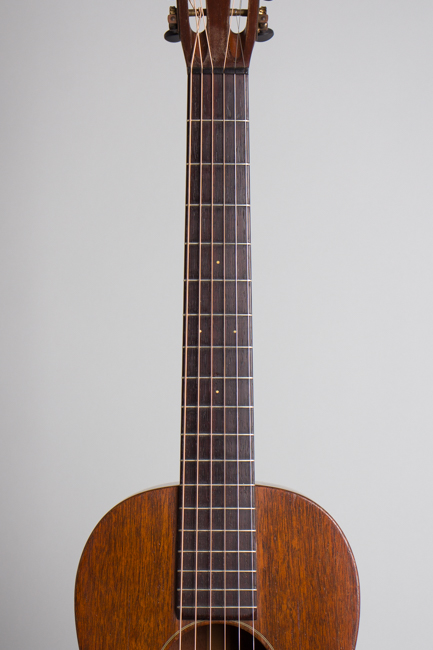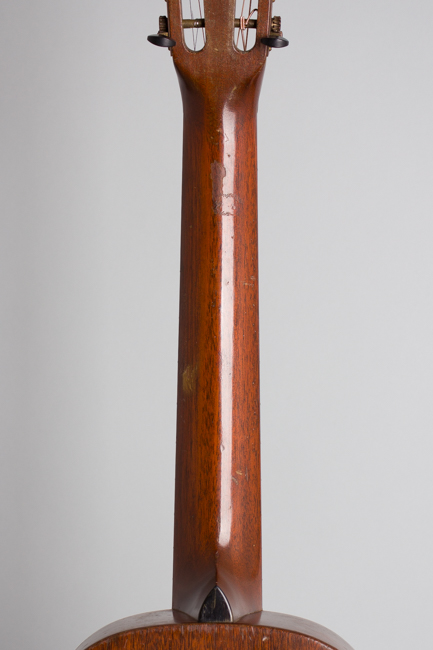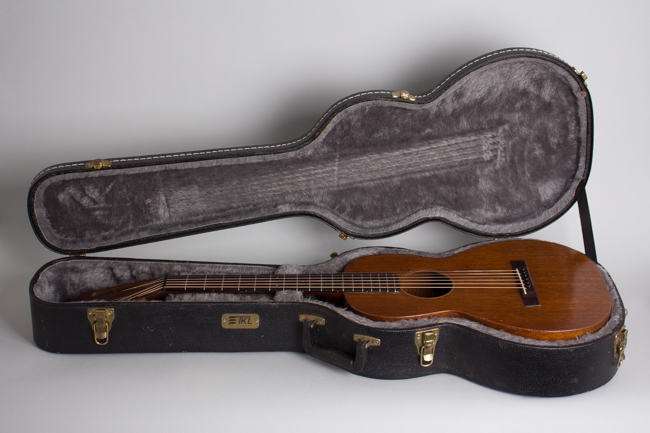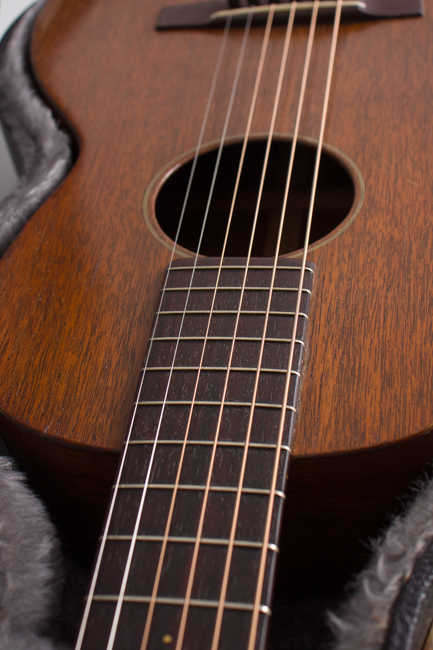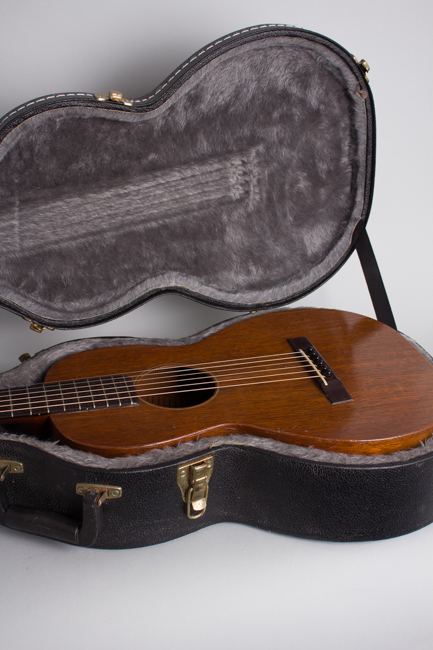C. F. Martin 2-17 Flat Top Acoustic Guitar (1930)
This item has been sold.
Item # 11398
Prices subject to change without notice.
C. F. Martin 2-17 Model Flat Top Acoustic Guitar (1930), made in Nazareth, PA, serial # 42620, natural mahogany finish, mahogany body and neck, ebony fingerboard, black tolex hard shell case.
The 2-17 is a small and rather unassuming guitar, but as Martin's first dedicated steel-string it helped change the course of the company's history. Until the early 1920s, the C. F. Martin Company considered gut-strung guitars the norm, with steel stringing a cheap and somewhat low-class anomaly. The popularity of Jazz and Hawaiian styles made this a very redundant strategy, and in 1922 the all-mahogany 2-17 was introduced with steel strings as the standard appointment. It was a low budget guitar, in keeping with the concept that only cheap players used steel strings!
The 2-17 is very basic, with all mahogany construction and minimal appointments. At the end of 1929 (by which time nearly all Martins came stock strung with steel) it was made more basic still by eliminating even the discreet rosewood bindings on the edges. This allowed the guitar to be sold for $25, which was a paltry sum for a Martin, but actually still a fairly expensive guitar at the time. You could get a pearl-trimmed rosewood instrument from Sears for not too much more! The minimal appointments included a plain straight bridge and small-dot inlaid fingerboard of rosewood, all else being mahogany.
The 2-17 was the right guitar at the right time, a Martin mainstay through the worst years of the Depression. This one was made in 1930, just as the US economy was collapsing and many instrument makers were scrambling to survive. It is one of the first of the "New Model" unbound 2-17s, of which only 50 were shipped this year. It shows some wear but remains a fine playing and sounding example with a sparkly tone and surprising power and depth for its diminutive body. This model is most associated with Jimmy Rodgers, who played one at the beginning of his career before his Victor records successes enabled him to purchase the considerably more costly Custom 000-45 that became his trademark!
Overall length is 37 in. (94 cm.), 12 1/4 in. (31.1 cm.) wide at lower bout, and 4 in. (10.2 cm.) in depth at side, taken at the end block. Scale length is 24 3/8 in. (619 mm.). Width of nut is 1 3/4 in. (44 mm.).
This is a moderately worn-in 90+ year old guitar but still an excellent player. The all-original finish shows numerous dings, dents, and scratches, with some deeper scratching to the lower waist and on the back. The finish shows some moisture damage along the lower bout on back and sides. The finish on the back of the neck is not heavily worn from play, there are a few dings and dents and a feelable spot of capo wear behind the 2nd fret.
There is a very small impact repair on the upper side bass bout, with a tiny piece of mahogany patched in neatly with no overfinish. Two side cracks on the treble side have been repaired, one at waist cleated, another at the lower bout topically sealed.
The top is very solid with only minimal bulging which is something often seen on this model. Internally a number of braces have been reglued bit all the brace material remains original. The small maple bridge plate is a correct repro; the original bridge has been reglued with some light chipping around the edges. It retains the original ebony nut and the original rosewood bridge has been lowered on treble side and is fitted with a newer bone saddle and bridge pins.
The neck has been reset, the original bar frets polished out and playability is excellent. The tuners the original unplated strips, showing some general corrosion but still fully functional. This guitar is a fine player's example of this humble but very cool early Depression-era Martin, ready to hop a freight train (or more realistically an airplane) in a modern HSC. Overall Very Good + Condition.
The 2-17 is a small and rather unassuming guitar, but as Martin's first dedicated steel-string it helped change the course of the company's history. Until the early 1920s, the C. F. Martin Company considered gut-strung guitars the norm, with steel stringing a cheap and somewhat low-class anomaly. The popularity of Jazz and Hawaiian styles made this a very redundant strategy, and in 1922 the all-mahogany 2-17 was introduced with steel strings as the standard appointment. It was a low budget guitar, in keeping with the concept that only cheap players used steel strings!
The 2-17 is very basic, with all mahogany construction and minimal appointments. At the end of 1929 (by which time nearly all Martins came stock strung with steel) it was made more basic still by eliminating even the discreet rosewood bindings on the edges. This allowed the guitar to be sold for $25, which was a paltry sum for a Martin, but actually still a fairly expensive guitar at the time. You could get a pearl-trimmed rosewood instrument from Sears for not too much more! The minimal appointments included a plain straight bridge and small-dot inlaid fingerboard of rosewood, all else being mahogany.
The 2-17 was the right guitar at the right time, a Martin mainstay through the worst years of the Depression. This one was made in 1930, just as the US economy was collapsing and many instrument makers were scrambling to survive. It is one of the first of the "New Model" unbound 2-17s, of which only 50 were shipped this year. It shows some wear but remains a fine playing and sounding example with a sparkly tone and surprising power and depth for its diminutive body. This model is most associated with Jimmy Rodgers, who played one at the beginning of his career before his Victor records successes enabled him to purchase the considerably more costly Custom 000-45 that became his trademark!
Overall length is 37 in. (94 cm.), 12 1/4 in. (31.1 cm.) wide at lower bout, and 4 in. (10.2 cm.) in depth at side, taken at the end block. Scale length is 24 3/8 in. (619 mm.). Width of nut is 1 3/4 in. (44 mm.).
This is a moderately worn-in 90+ year old guitar but still an excellent player. The all-original finish shows numerous dings, dents, and scratches, with some deeper scratching to the lower waist and on the back. The finish shows some moisture damage along the lower bout on back and sides. The finish on the back of the neck is not heavily worn from play, there are a few dings and dents and a feelable spot of capo wear behind the 2nd fret.
There is a very small impact repair on the upper side bass bout, with a tiny piece of mahogany patched in neatly with no overfinish. Two side cracks on the treble side have been repaired, one at waist cleated, another at the lower bout topically sealed.
The top is very solid with only minimal bulging which is something often seen on this model. Internally a number of braces have been reglued bit all the brace material remains original. The small maple bridge plate is a correct repro; the original bridge has been reglued with some light chipping around the edges. It retains the original ebony nut and the original rosewood bridge has been lowered on treble side and is fitted with a newer bone saddle and bridge pins.
The neck has been reset, the original bar frets polished out and playability is excellent. The tuners the original unplated strips, showing some general corrosion but still fully functional. This guitar is a fine player's example of this humble but very cool early Depression-era Martin, ready to hop a freight train (or more realistically an airplane) in a modern HSC. Overall Very Good + Condition.
